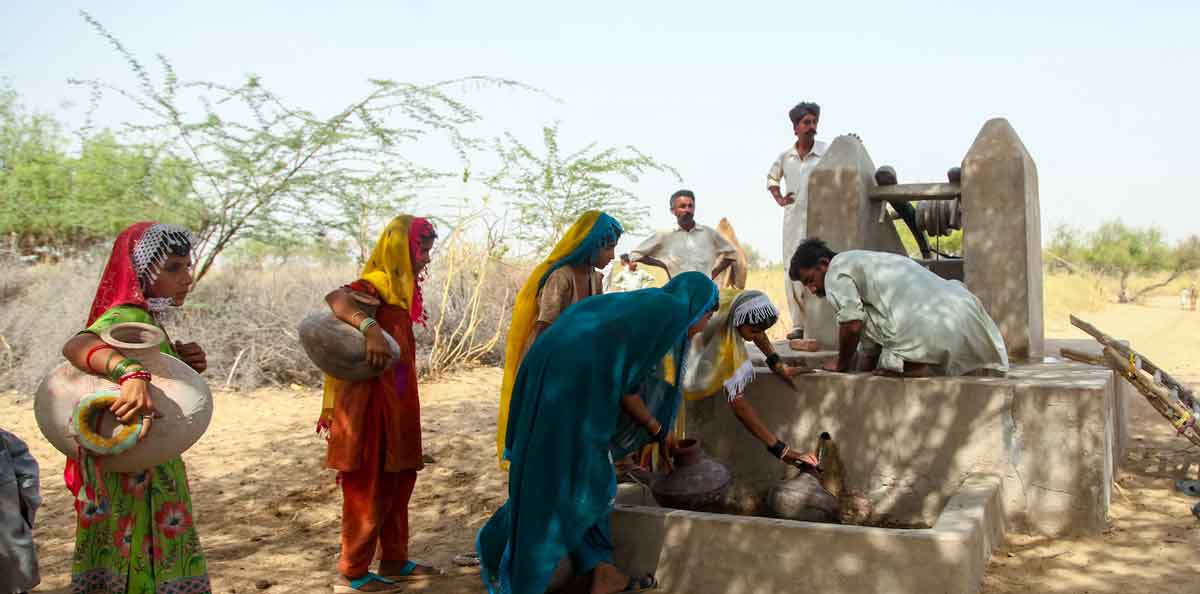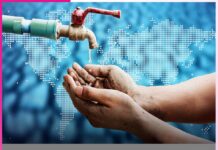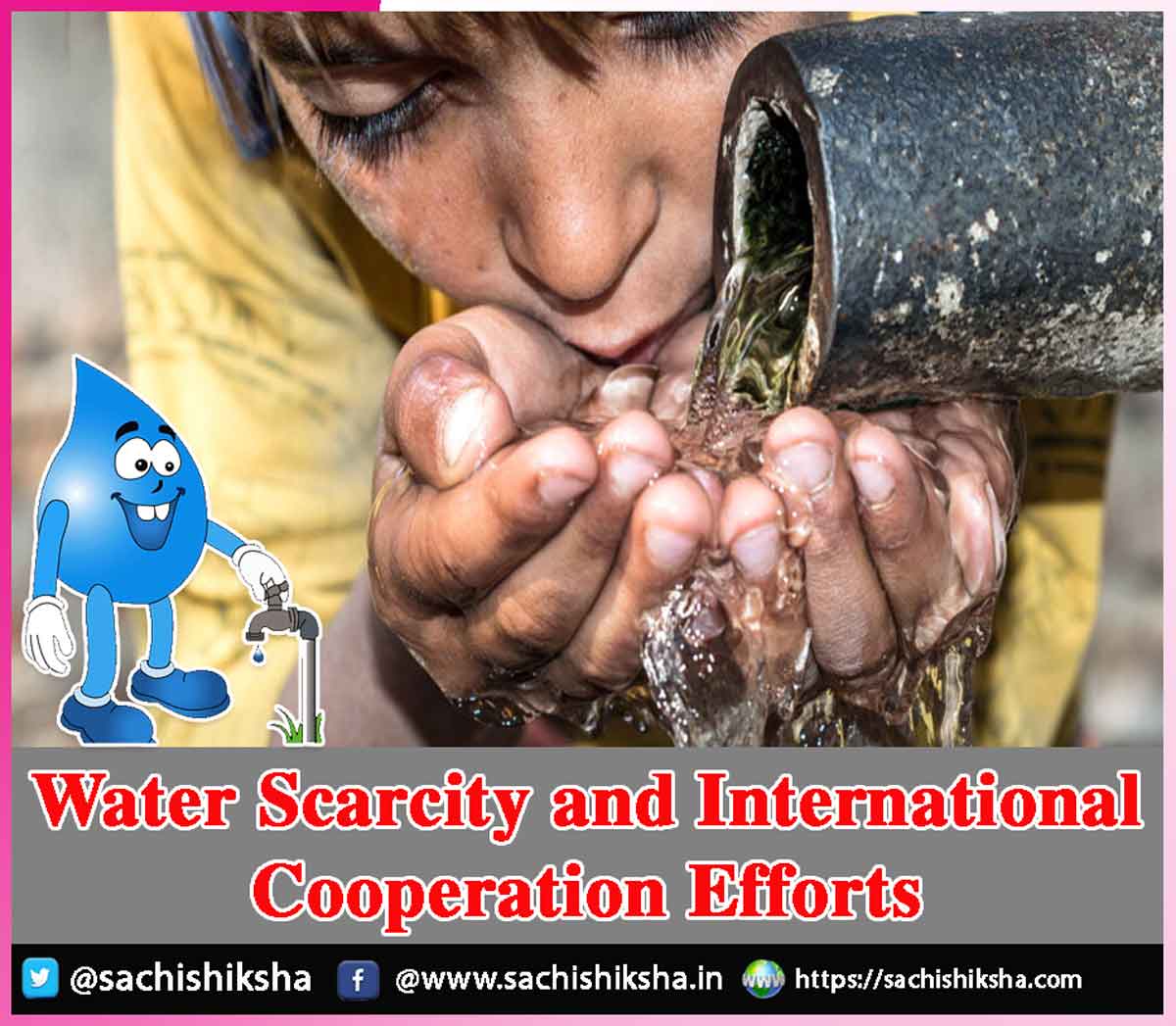Water Scarcity and International Cooperation Efforts
Introduction: Water is an essential resource for human survival, economic development, and environmental protection. In addition, groundwater problems can induce subsidence of the landscape, increased deforestation, and soil deterioration, exacerbating the water scarcity problem. Despite its critical importance, water scarcity affects over two billion people globally and is becoming more severe due to climate change, population growth, pollution, and inefficient water use.
As the challenges associated with water scarcity are transboundary and complex, no single nation can address them in isolation. International cooperation has thus emerged as a critical component in ensuring equitable access, sustainable management, and long-term solutions to global water scarcity.
Table of Contents
Understanding Water Scarcity

- Physiological Scarcity: It takes place when water supplies from nature are inadequate to support the needs of a given population. Regions suffering from physical water scarcity often face challenges such as limited access to groundwater, rivers, or lakes, which can be exacerbated by factors like climate change, desertification, or the over-extraction of groundwater.
- Economic Scarcity: This happens when there is enough water available in a region, but economic or political factors prevent access to water. This type of scarcity can be caused by poor infrastructure, lack of investment, or inefficient water management practices.
Water scarcity affects agricultural productivity, health outcomes, economic performance, and even international security, making cooperative approaches imperative.
The Need for International Cooperation
Water does not respect political boundaries. There are over 260 international river basins that span across more than 150 countries. Mismanagement or unilateral actions in upstream countries can have devastating impacts on downstream nations. International cooperation helps in:
- Preventing conflicts over water;
- Promoting equitable sharing of resources;
- Facilitating joint investments in infrastructure;
- Enhancing data sharing and early warning systems;
- Supporting capacity building and institutional development.
-
Global Distribution of Water Resources

Water Availability by Region
- Northern and Central Europe: These regions generally have ample freshwater resources, with consistent rainfall and efficient management practices. As a result, they face fewer issues with water scarcity compared to other regions.
- Sub-Saharan Africa: Many countries in sub-Saharan Africa are severely water-stressed, with populations often relying on seasonal rainfall and unreliable water sources. Access to clean drinking water remains a significant challenge in many areas, and water scarcity is compounded by factors such as rapid population growth, political instability, and infrastructure deficits.
- South Asia: Countries like India, Pakistan, and Bangladesh are experiencing increasing water stress due to a combination of factors including population growth, over-extraction of groundwater, and agricultural demands. Climate change is also predicted to worsen water availability in this region, with the melting of the Himalayan glaciers posing a particular threat to water security.
- The Middle East and North Africa Region: This region has limited availability of freshwater, making it one of the worldwide greatest water-scarce areas. Much of the region depends on desalination or imports of water, and groundwater resources are often over-exploited.
- Latin America: While regions like the Amazon Basin have abundant freshwater, other areas, such as parts of Mexico, Chile, and Argentina, are facing significant water scarcity due to over-extraction, pollution, and the impacts of climate change.
- North America: The United States and Canada have relatively abundant water resources, but regions such as the southwestern United States, including California and Nevada, face ongoing water scarcity due to drought, high demand, and competition for water from agriculture, industry, and urban areas.
Key Frameworks and Treaties for Transboundary Water Cooperation
The UN Watercourses Convention (1997):
The convention establishes basic principles for the use and management of shared watercourses. These include:
Equitable and reasonable utilization of water resources and duty to cooperate through mechanisms such as information exchange and notification, though not universally ratified, it provides a valuable normative framework for resolving transboundary water disputes.
The Helsinki Rules (1966) and Berlin Rules (2004):
Developed by the International Law Association, these rules offer guidance on international water law. The Helsinki Rules introduced the concept of equitable use, while the Berlin Rules expanded the framework to include environmental sustainability and human rights principles. These rules have influenced many bilateral and regional agreements.
The UNECE Water Convention (1992):

- Integrated water resource management (IWRM);
- Joint monitoring and assessment;
- Shared infrastructure and data sharing.
Countries such as Kazakhstan, Kyrgyzstan, and Uzbekistan have used this convention to improve shared water governance.
Regional Cooperative Efforts
Nile Basin Initiative (NBI): The Nile Basin Initiative, launched in 1999, is a regional partnership seeking to “develop the river in a cooperative manner, share substantial socioeconomic benefits, and promote regional peace and security.”
Achievements: Its achievements include:
- Establishing shared data repositories and hydrological monitoring;
- Developing joint infrastructure projects;
- Enhancing regional dialogue and conflict prevention.
- However, political tensions persist, particularly between upstream (e.g., Ethiopia) and downstream (e.g., Egypt) countries.
Mekong River Commission (MRC):
The Mekong River Commission, formed in 1995 by Cambodia, Laos, Thailand, and Vietnam, is an intergovernmental organization that facilitates cooperation on sustainable water development.
Its key successes: Its key successes include:
- Promoting regional flood forecasting and drought management systems;
- Facilitating discussions on hydropower development impacts;
- Providing scientific and technical data for informed decision-making.
Indus Waters Treaty (1960):
The World Bank arranged one of the world’s longest-standing water deals, India-Pakistan’s Indus Waters Treaty, in 1960. Despite multiple wars and tensions, the treaty has largely held, demonstrating how well-structured agreements can promote cooperation even in hostile geopolitical environments.
Role of International Organizations and Institutions
-
International Cooperation Efforts to Address Water Scarcity
Given the global nature of water scarcity, cooperation at the international level is essential for finding sustainable solutions. Several international organizations, treaties, and initiatives have been established to address water scarcity and promote water conservation.
The United Nations and Water Scarcity
The United Nations (UN) has been a key player in addressing global water scarcity through initiatives like the UN Water and the UN Sustainable Development Goals (SDGs). The UN has launched various programs to improve water access, promote water conservation, and encourage sustainable water management practices.
International Water Treaties and Agreements
The 1997 UN Convention on the Law of the Non-Navigational Uses of International Watercourses, provides a framework for the peaceful and equitable use of shared freshwater resources.
The UN has played a crucial role in shaping global water governance through:
UN-Water: A coordinating body bringing together over 30 UN agencies working on water-related issues.
- The Nile Basin Initiative: This is an example of regional cooperation between the countries that share the Nile River.
- The Indus Waters Treaty: Signed between India and Pakistan in 1960, this treaty has successfully managed the use of the Indus River system, despite political tensions between the two countries. However, it has been suspended by the Indian Government following a Pakistan-promoted terrorist attack in Pahalgam
International Organizations and NGOs
- The World Bank has invested in water infrastructure projects in developing countries, focusing on improving access to clean water and sanitation, and promoting water conservation practices.
- The World Health Organization (WHO) has been working to improve water quality and access to sanitation to reduce waterborne diseases.
Technology and Innovation
Advancements in technology, such as desalination, wastewater treatment, and efficient irrigation systems, have the potential to significantly improve water availability in water-scarce regions. International cooperation in research and development is crucial for scaling up these technologies and making them affordable for developing countries.
The Food and Agriculture Organization (FAO)
It promotes practices such as drip irrigation, rainwater harvesting, and water reuse. FAO also helps countries assess water productivity and develop national water plans.
Technological and Scientific Collaboration
Data Sharing and Early Warning Systems;
Real-time data sharing on rainfall, river flows, and groundwater levels is crucial for managing shared water resources. Regional efforts like the Famine Early Warning Systems Network (FEWS NET) provide crucial insights into drought conditions and water scarcity risks.
Desalination and Water Reuse Technologies
Countries in the Gulf Cooperation Council (GCC), facing acute water scarcity, have become leaders in desalination technology. Through regional partnerships, they collaborate with European and Asian countries on research into cost-effective and sustainable desalination methods. Technological cooperation has also led to innovations in wastewater treatment and water recycling, especially in Israel, Singapore, and parts of the United States. Its impacts are felt across public health, economic development, the environment, and social stability.
Conclusion
Addressing water scarcity requires the collective effort of governments, international organizations, businesses, and individuals. Only through continued cooperation and innovation can the global community hope to overcome this challenge and secure water for future generations.














































